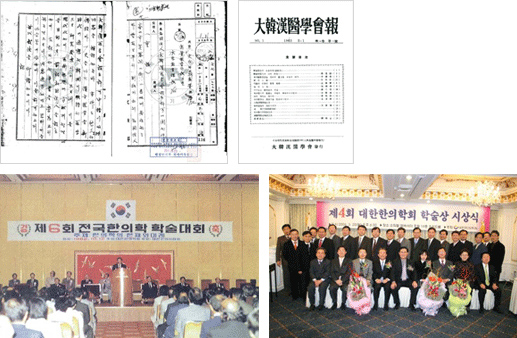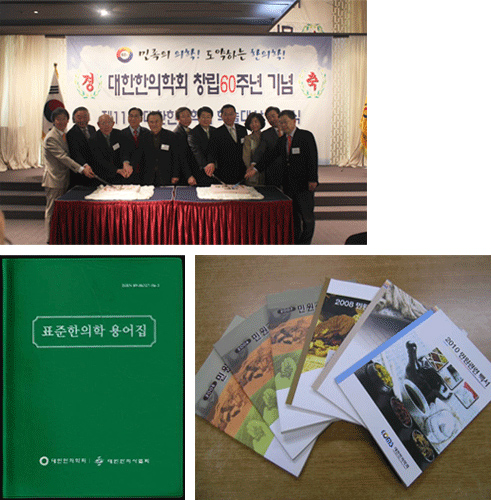About SKOM
History
1953
The Society of Korean Medicine(SKOM) was launched in January 31, 1953, one year after Union of Korean Medicine Doctors was organized. Subsequently, however, because of social chaos and others, the administrative works of SKOM were not active for several years. Then, in 1959, the title of Unio n of Korean Medicine Doctors was changed into the Association of Korean Medicine, and the articles of the Association of Korean Medicine was passed on September 20, 1962, which put SKOM as a subsidiary body under the cooperation, not an independent body. Then, in 1999, SKOM became independent of the Association of Korean Medicine. As of 2012, SKOM, as an independent body succeeding to the old tradition of SKOM, tries hard to reflect scholastic desires of those involved in Korean medicine and wishes of those to see a new medical science.


1963
In terms of the history of activities, the first edition of the Journal of Korean Oriental Medical Society was published on May 1, 1963, and country-wide academic meetings were hosted by the society since that year. in 1966, the projects of translating Dongeuibogam and of setting up Korean medicine terms were selected as part of the greater project of sorting out the classics on Korean medicine. Also, the directors of the society have upgraded qualities of Korean medicine practitioners through their circulating tour lectures countrywide and distributed the knowledge of Korean medicine by promoting the publication of the books on Korean medicine.
1970
In the 1970s, based on the foundation of initial stage, more advanced academic projects were implemented. In 1970, for example, SKOM was commissioned by the Department of Health and Welfare the project of 'establishment of disease names to classify statistically diseases/injury and causes of death' to be submitted to the World Health Organization (WHO). On July 6 of that year, SKOM submitted to the government the book of over 1,000 pages covering all the disease names used in Korean medicine, securing the basis on which prescriptions of Korean medicine practitioners could be recognized internationally. Around that time, SKOM also led the supplementary training project for Korean medicine practitioners under the amended Medical Law, which became active from 1971. By establishing the award of Korean medicine, it helped to enhance the desires of scholastic researches among those working in Korean medicine. It hosted lectures of famous practitioners in acupuncture and moxibustion by inviting them to Korea. And, it held the World Acupuncture and Moxibustion Scholastic Meeting in 1973 for the first time in Korean history.
1979
In 1979, the Society participated deeply into the government’s Korean medicine development & cultivation project, such as the survey of the status of Korean medicine. For example, supported by the Ministry of Health and Social Affairs, it started the project of translating classical Korean medicine literature. First of all, 25 volumes among 85 volumes of Hyangyagjibseongbang were completely translated by the end of the 1980s. The translated contents of the classics originally consisting only of chinese characters were described with both korean alphabets and chinese characters and the prescriptions were expressed in modern grams instead of old weight units. The second project of translating it from vol. 26 through vol. 50 was also finished.
Also, the project of publishing Standard Prescriptions in Korean Medicine was implemented in the years of 1978 and 1979 to supplement the weak points of korean medicine and to explore good prescriptions. With the research area limited to the clinical area, and college professors in various fields appointed as research members, the book was the comprehensive collection of what proved to be effective in clinical treatment, what were applied most frequently, what had firm grounds in related literature, and what proved to be effective in objective perspective in korean medicine ranging from internal medicine, surgery, neurology, pediatrics, gynecology, and acupuncture & moxibustion. In october 1980, 5 months after the project was launched, a 500 page book containing 1433 prescriptions and 212 acupuncture & moxibustion methods was published. It contained tens of thousands of korean medicine prescriptions from the time of Junggyeongjeonseo to the current age classified and arranged to meet the universality of the current medical system, commonness of treatment effect, and scientific aspects of the medical care area.
In August 1981, the book was published by the Association of Korean Medicine with the title of Standard Prescriptions in Korean Medicine under the approval of publication by the Ministry of Health and Social Affairs. Standard Prescriptions in Korean Medicine has been valuated as the first publication in the field of general korean medicine with the government's financial support since the publication of Dongeuibogam (in 1612).


1986
Also, in 1986, the Comprehensive Literature Collection of Korean Medicine which listed all the books, papers and theses on korean medicine published during the 40 years after the Second World War. Part 1 of the book listed original books, compiled books, and translations; Part 2 master's and doctoral theses and dissertations; Part 3 scholastic papers in korean and foreign journals; Part 4 clinical reports; Part 5 reports/records, persons, and others; the Appendix consisted of the index of personnel.
1989
In 1989, SKOM held the joint publication ceremony of korean medicine books. It registered all the original books and translations published since 1982, and appreciated the efforts of members who wrote them for contributing to the academic development through writings on korean medicine.
1999
Since the operation of SKOM became independent in 1999, the basic guidelines were set on the following matters, and those have been promoted: research and development of the theory and technology in korean medicine; certification and guide/cultivation of sub-societies; collection of korean medicine books and literatures and publication of academic journals; international exchange of and cooperation in korean medicine; the training of korean medicine; what are commissioned by the Association of Korean Medicine; supplementary training of korean medicine doctors.
2012
As of 2012, major projects of SKOM are as follows: publication of the Journal of the Korean Medicine Society; activation of activities of sub-field societies and support for issuing journals of them; selection of scholastic grand prix of SKOM; project of setting up terms of korean medicine; R&D project on standardized medical activities of korean medicine; EBM research project; holding of nation-wide scholastic seminars on korean medicine; holding of seminars on specific topics; production and distribution of posters designed to publicize korean medicine to the people; consultation on medical disputes and scholastic matters; scholastic exchange and cooperation with similar societies and associations overseas such as the Japan Society for Oriental Medicine and the Japan Society of Acupuncture and Moxibustion, Chunghwa Chinese Medicine Society (of Taiwan), and World Federal Chinese Medicine Societies, and so on; running of the SKOM homepage and the webzine; matters related with examination for licensing specialists on korean medicine, etc.
2013
On March, 23, 2013, on the sixtieth anniversary of the foundation of the society of Korean medicine, institutional heads of Korean medicine gathered together for celebration. On this date, the society of Korean medicine pledged to put efforts for Korean medicine to have evidence from objective indices, and to be prepared with international competitiveness.
2016
As of 2016, the major projects of the society are : publication of journal of Korean medicine, activation of member societies and funding for the member societies‘ journals, grand prize of society of Korean medicine, enactment of academic terminology of Korean medicine, standard medical service development and research of Korean medicine, EMB research, hosting of national conference of Korean medicine, hosting of planned seminars, consultation on medical disputes and academic matters, academic exchange and cooperation with Japanese society of oriental medicine, Japanese society of acupuncture and moxibustion, Chunghwa Chinese Medicine Society, and other international societies, website of the society, and announcements for specialized doctors of Korean medicine.
Member societies became more active and specialized starting in the 1970s with university‘s department leading the academic divisions. In 1984, eleven academic divisions were approved to be under the society of Korean medicine. The issuing of journals, hosting of conferences, and overall activities of the society is evaluated every year to check the activation and approval status of the member society. In 2013, thirty six academic divisions were approved as member societies, and ten as associate member societies. From October, 2013, academic divisions were called as member societies, and as of 2018, there are forty four member societies and fifteen associate member societies approved under the society of Korean medicine.
Each member society issues at least two times of journals a year, and hosts academic conference and also hosts international conferences for globalization of Korean medicine.
2020
Since the COVID-19 pandemic has made it impossible to gather a large number of people offline, we conducted the first online maintenance training in the Korean medicine community to share the latest knowledge of oriental medicine with members and seek a place for progressive academic discussions. More than 6,000 members of the Korean medicine clinic attended and shared their experiences, and tried to improve the professionalism and rights of Korean medicine doctors by providing various contents.
2021
The Standard terminology of Korean medicine compilation project began in 2000 at SKOM (Standard terminology of Korean medicine selection and commentary work) in SKOM.
The publication of Standard terminology of Korean medicine 2.1ver systematically organized the existing Standard terminology of Korean medicine 1.0 and 2.0 (a total of 12,795 terms, 16 academic societies), contributing to education, treatment of korean medicine, preparation of various official documents, and standardization of korean medicine information by organizing the Korean medicine in the field of korean medicine.
2023
On January, 14, 2023, on the 70th anniversary of the foundation of the society of Korean medicine, institutional heads of Korean medicine gathered together for celebration.
On this date, it promised to make efforts to promote the excellence of oriental medicine through active academic research, exchange activities, and globalization.
2024
On Septermber, 7, 2018, After signing a memorandum of understanding (MOU) at the International Conference on Academic Exchange (ICMART-iSAMS 2018) held in Munich.
ICMART's membership in 2019 was approved and confirmed as the host country of ICMART 2024. The ICMART2024 Congress, held in September 2024 at the Shinhwa World in Jeju Island for the first time in East Asia, was the largest general meeting ever with a total of 1,007 people from 37 countries and served as an opportunity to inform medical professionals around the world of the excellence of korean medicine.




